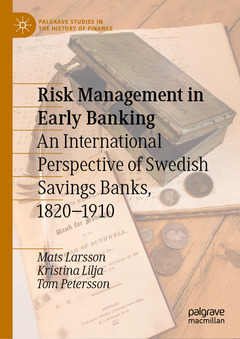Description
Risk Management in Early Banking, 1st ed. 2021
An International Perspective of Swedish Savings Banks, 1820–1910
Palgrave Studies in the History of Finance Series
Authors: Larsson Mats, Lilja Kristina, Petersson Tom
Language: English
Subjects for Risk Management in Early Banking:
63.29 €
In Print (Delivery period: 15 days).
Add to cart120 p. · 14.8x21 cm · Hardback
Description
/li>Contents
/li>Biography
/li>Comment
/li>
This book deals with risk management and the organisation of banking in Swedish savings banks alongside the development in other European countries. The period of analysis begins with the establishment of the first savings banks in 1820 and ends in 1910. During this period, banking developed as a well-functioning system for deposits and credits. The book focuses on this development from a theoretical perspective connected to risk management and the role of trust and legitimacy in credits and savings. The analysis deals with the overall development of the Swedish banking system and the role of savings banks as well as bank connections with different groups of customers. Of interest to financial historians, academics, and researchers, it also analyses the role of insider lending and the practical aspects of granting credits, such as the use of collaterals and the level of interest rates to compensate higher risks.
Chapter 1: Introduction.- Chapter 2: Sweden, an economy in transformation, 1820-1910.- Chapter 3: Savings banks in the Swedish banking system.- Chapter 4: Savers and the risk of deposit banking.- Chapter 5: Credit risks – from networks and co-operation to stable markets.- Chapter 6: Trust and mistrust – practical aspects of risk management and lending in the 1890.- Chapter 7: A comparative conclusion.
Mats Larsson is Professor of Economic History at Uppsala University, Sweden.
Kristina Lilja is a Senior Lecturer in Economic History at Uppsala University, Sweden.
Tom Petersson is a Senior Lecturer in Economic History at Uppsala University, Sweden.
These books may interest you

The Oxford Handbook of Banking 152.43 €



